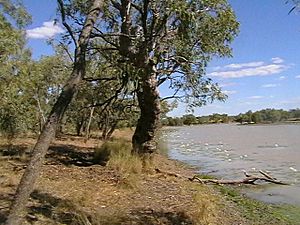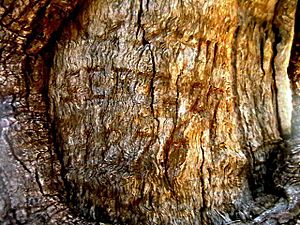Hodgkinson's Marked Tree facts for kids
Quick facts for kids Hodgkinson's Marked Tree |
|
|---|---|

Hodgkinson's Marked Tree, 2007
|
|
| Location | Rocklands Station, Camooweal, City of Mount Isa, Queensland, Australia |
| Official name: Hodgkinson's Marked Tree | |
| Type | state heritage (landscape) |
| Designated | 21 October 1992 |
| Reference no. | 600741 |
| Significant period | 1876 (historical) |
| Lua error in Module:Location_map at line 420: attempt to index field 'wikibase' (a nil value). | |
Hodgkinson's Marked Tree is a special tree located at Rocklands Station, near Camooweal in Queensland, Australia. It's listed on the Queensland Heritage Register because of its important history. This tree was marked by an explorer named William Hodgkinson way back in 1876.
Contents
The Tree's Story: An Explorer's Mark
This famous tree is on the northeastern shore of Lake Mary. It's part of Rocklands Station, which is close to Camooweal. The tree was marked during an expedition led by William Hodgkinson in 1876. This trip was the last big government-sponsored exploration in Queensland. Its main goal was to find new land for grazing animals in far western Queensland.
Early Explorers and Settlers
Before Hodgkinson, another explorer named William Landsborough passed through the Camooweal area. This was in 1861–62, when he was searching for the missing Burke and Wills expedition. Landsborough's reports encouraged people to settle here.
The first settlers, called pastoralists, started sheep farms in the area a few years later. John Sutherland was one of the first to get a lease for Rocklands in 1865. However, he faced many problems. Wild dogs called dingos attacked his sheep. It was also very isolated, and it was hard to find workers or transport goods. Because of these difficulties, he had to give up his lease.
In 1875, Benjamin Crosthwaite bought the Rocklands lease. A year later, in September 1876, William Hodgkinson's expedition camped by Lake Mary. This was on Crosthwaite's property, near the station's main buildings.
Who Was William Hodgkinson?
William Oswald Hodgkinson was a very interesting person. He first came to Australia in 1851 as a young sailor. Later, he worked for the government in Victoria. He also became a journalist and helped start newspapers in Rockhampton and Mackay.
Hodgkinson was even part of the famous, but ill-fated, Burke and Wills expedition in 1860. The next year, he joined the search party looking for them. He later became a mining warden and police magistrate in gold mining areas. He also served as a Member of Parliament several times. He even became a government minister, looking after mines and public education.
Hodgkinson's Expedition and the Marked Tree
In 1875, the Queensland Government asked Hodgkinson to explore new grazing lands. They wanted him to look around the Diamantina River and areas towards South Australia. In September 1876, Hodgkinson reached Lake Mary. Here, he found a tree that Landsborough had marked back in 1861.
Just like Landsborough, Hodgkinson also marked a tree to show his expedition had been there. He carved a special symbol: a "broad arrow over H over LXXXVIII over 27-10 over 1876". This marking showed it was his 88th camp. The date in his report was September 27, not October. This was the last tree Hodgkinson reported marking on this expedition.
Marking trees was a common practice for explorers. It helped others follow their paths. Hodgkinson's efforts helped open up valuable land for farming in western Queensland. This led to the development of the region.
The Tree Today
In 1983, the National Trust of Queensland added Hodgkinson's Marked Tree to its Register of Significant Trees. At that time, the original carvings were still easy to see. The tree was officially added to the Queensland Heritage Register in 1992.
On Christmas Day in 2003, a family visited the tree by boat. They reported that the tree was healthy and still leaning over Lake Mary.
What the Tree Looks Like
The Hodgkinson Tree is a mature Coolibah tree (scientific name: Eucalyptus microtheca). It stands on the northeastern bank of Lake Mary. This lake is part of the Georgina River system.
The tree leans over the lake. A photograph from around 1983 shows the carvings clearly. They are above a fork in the trunk. The carvings show a broad arrow over H over LXXXVIII over Sep 27 over 1876. These markings are still believed to be visible today.
Why This Tree is Important
Hodgkinson's Marked Tree is listed on the Queensland Heritage Register for a few key reasons:
Demonstrating Queensland's History
This Coolibah tree is important because it shows how Queensland developed. It was marked on September 27, 1876, as Camp 88 of William Oswald Hodgkinson's expedition. This expedition was looking for new land for farms in western Queensland. The tree marks the end of Hodgkinson's main exploration work during this trip. Thanks to his efforts, valuable land was opened up. This helped western Queensland grow and develop. The tree is a symbol of how explorers mapped out the Australian interior in the mid-1800s. It's important proof of this major part of Queensland's history.
Association with William Oswald Hodgkinson
This marked tree is strongly connected to the work of William Oswald Hodgkinson. He was an explorer, a journalist, a goldfields warden, a police magistrate, and a politician. He contributed a lot to Queensland's development from the 1860s to the 1890s.


